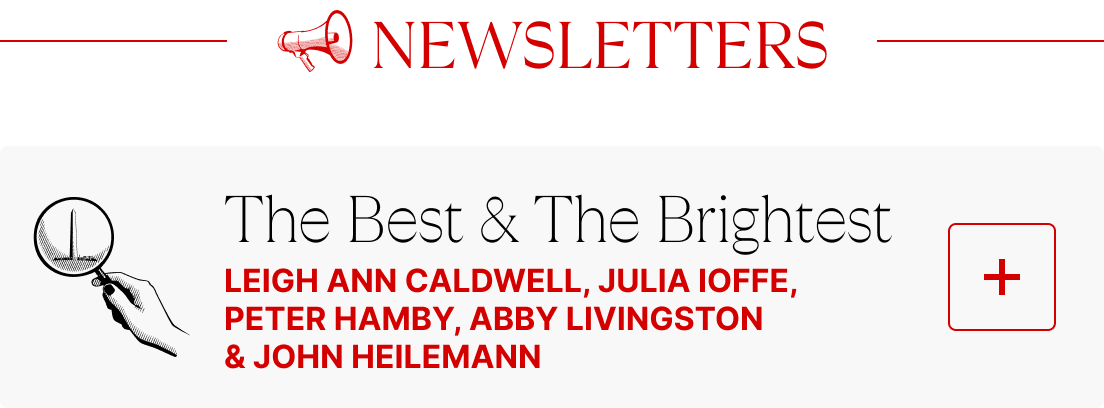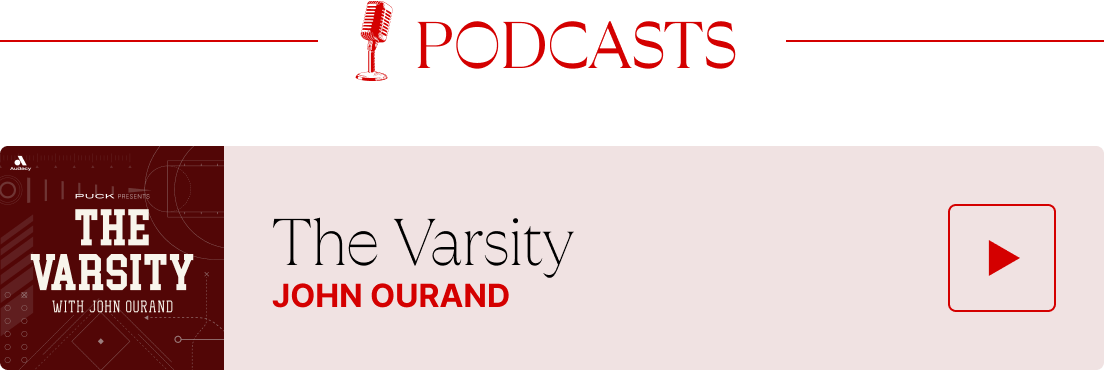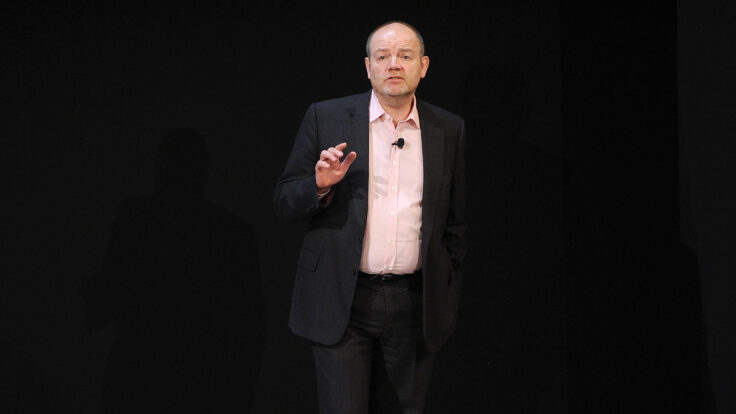Greetings from Los Angeles, and welcome back to In the Room. In case you missed it,
President Trump commended Jeff Bezos for “trying to do a real job with The Washington Post,” which “wasn’t happening before.” Real Rorschach test there for the folks at 1301 K Street…
In tonight’s issue, news and notes on The New York Times’s increasingly aggressive efforts to integrate A.I.
into every facet of its business—from editorial to UX to advertising—and the profound ramifications that this implementation will pose for the staff at 620 Eighth Avenue (many of whom are blithely unaware of the A.I. revolution), and the industry at large. Plus some news from my partner Matt Belloni, who got the inside story of Jeremy Zimmer’s ouster from UTA.
🍸 On the latest edition of The Grill Room, The Information founder and C.E.O.
Jessica Lessin joined me for a candid conversation about her pioneering tech news business; her investments in Semafor, The Ankler, and other startups; and the value of deep expertise and loyal audiences (and how much to charge them). We also assess the recalibration of Silicon Valley power players in the era of Trump 2.0. Follow The Grill Room on Apple,
Spotify, or wherever you prefer to listen.
Also mentioned in this issue: A.G. Sulzberger, Emma Tucker, Tucker Carlson, Alex Hardiman, Will Lewis, Jeremy
Boreing, Jackson Arn, Sam Dolnick, David Kramer, Jeffrey Toobin, Zach Seward, Danielle Weisberg, Carly Zakin, and many more…
Let’s get started…
|
- Arn you curious?: Since so many of you have inquired about the cause for Jackson Arn’s untimely defenestration from The New Yorker, I’ll put this at the top… On Monday, The New York Times reported that the august brand had cut ties with its newish art critic following complaints about his “inappropriate,” “intoxicated” behavior at the magazine’s 100th anniversary party last month. But the paper offered no further specifics—was
this classic Timesian prudishness, H.R. babble, or did they just not know? Well, I’m reliably told that Arn was indeed “intoxicated”—“blackout drunk” is how one person put it—and that he got handsy with a lot of men and women, including some senior leadership. Naturally, this resulted in complaints to Condé Nast H.R. (A generation ago, of course, people got promotions at the company despite this sort of gross behavior, as Michael Grynbaum’s forthcoming book on
Condé may depict.)
The general sentiment at The New Yorker, of course, is that this is all really a shame, and that’s the truth. Arn was a talented and hardworking writer at the dawn of his career, presumably fulfilling his dream job. In time, Arn may very well work his way back into the industry’s good graces—as similarly exiled Jeffrey Toobin eventually did—though sources rightly advised that he’d do well to learn from the incident and modulate his
social-professional behavior. (Arn and spokespeople for both The New Yorker and Condé Nast did not respond to requests for comment.)
- Boreing news: Daily Wire co-founder Jeremy Boreing is stepping down as co-C.E.O. of the conservative media startup. He will now focus on “creative projects” while
his partner Caleb Robinson becomes the sole chief executive. I don’t have firm intel on the reasons behind the move, and Jeremy won’t respond to my emails. But this could signal that the Ben Shapiro–led enterprise might not be performing quite as well as Jeremy suggested during an episode of
The Grill Room back in November.
At the time, as you may recall, he boasted more than $200 million in annual revenue and told me that the Wire “can be a $10 billion business, and will be.” And, for what it’s worth, I don’t discount any of that. Companies evolve and mature, and all we know is that relevant parties—whether that’s Shapiro, the board, Boreing, or others—think it will achieve that sort of escape velocity under different leadership.
- The
Skimm sells: The Skimm, the millennial woman–focused media company founded by co-C.E.O.s Danielle Weisberg and Carly Zakin in 2012, has finally found a buyer after spending several years searching for an exit. Axios reports that Ziff Davis, acquirer of myriad, mostly forgettable media brands—CNet, Mashable,
AskMen—has acquired the company and will place it in its very profitable Everyday Health group, which is an especially dominant player in the expecting- and early-mothers space. Jeff Zucker, the RedBird IMI chief and a Skimm board member, called the deal “a terrific opportunity for growth.” That said, there are also some red flags here. As Axios’s Sara Fischer notes, subscriptions across its products are down from 7 million to 5 million and, when asked
if the company was profitable, the founders pointed to “a track record as a company of profitability.” Also, no transaction price was announced for a company that raised nearly $30 million. Do their institutional investors all view this as a terrific opportunity?
- Finally, from the Grill Room mailbag: After last week’s Grill Room episode with Wall Street Journal E.I.C. Emma Tucker, a reader in the finance space offered
the following prediction: “It seems like there is a strong chance we will wake up 6-9-12 months from now and realize that the WSJ might be the WaPo (and NYT, to an extent) of 2017—e.g., the publication that receives a substantial/material Trump bump.” This Nostradamus continued: “I think it’s lining up well, particularly if they continue their string of scoops on the White House/Trump orbit while continuing to gain momentum in the broader things that Emma is
leading (the tangential stories that become must-reads).”
I think this reader is onto something, and I imagine the editorial board’s thoughtful Trump criticisms and provocations could help fuel the bump. In the most recent News Corp. earnings, the Journal’s digital subscriber number was up 4 percent, to 4.2 million. I’ll keep everyone updated on this magic number.
|
|
|
A MESSAGE FROM OUR SPONSOR
|
Medicines are the one part of health care where costs go down over time.
America’s intellectual property (IP) system is designed to make medicines more affordable for patients through innovative research, brand competition and lower-cost generics. Today, 90% of prescriptions are filled with lower-cost generic and biosimilar medicines.
Learn more.
|
|
|
And now, my partner Matt Belloni’s excellent reporting on the Jeremy Zimmer news…
|
|
|

|
Matthew Belloni
|
|
How UTA’s Jeremy Zimmer Lost
the Troops
|
Was anyone really surprised to see United Talent Agency replace its longtime C.E.O.
Jeremy Zimmer? That’s what the announcement was this morning, of course: an old-fashioned Hollywood firing by UTA’s board of directors, spun as a long-planned “succession” with the usual “staying on board to aid the transition” language. Zimmer is an old-school talent agency guy, so I kinda wish he had just come out and said it the way agents often talk about studio executives: “I got shitcanned.”
No shame. Zimmer had a great run, growing UTA, which he co-founded back in
1991, into a solid number three talent agency behind CAA and WME. I know, Jeremy has big fans… and major detractors; I’ve always liked him personally, though in my experience, he’s got a Jan Brady quality to him—enormously successful yet perpetually thirsty to be equated with Bryan Lourd at CAA and Ari Emanuel at Endeavor/WME, two of the best agents and most ambitious leaders in the history of Hollywood. Hence, Zimmer’s bravado in meetings and many
spotlight-seeking media appearances, including this unforgettable two-shot with UTA client DJ Khaled, and unfortunate foot-in-mouth moments like at a Financial Times conference last fall, where Zimmer admonished creators “to be a little bit more daring in the work they want to do because it’s
gotten a bit repetitive.” Said the guy who has never created anything and isn’t really a talent agent anymore.
Still, with major outside investment over the years, including lately from Swedish private equity firm EQT, Zimmer oversaw not just the survival of UTA amid fierce competition, but the expansion of the company into sports (via Rich Paul’s Klutch), broadcasters (via Bienstock Group), fashion, books, and several other
verticals—about 20 acquisitions in total, though splashy forays into fine art and a ventures group were shuttered or downsized. And the 2022 acquisition of London-based agency Curtis Brown Group, one of UTA’s most successful deals, was spearheaded by David Kramer, the agency’s president, who will now succeed Zimmer.
Zimmer declined to speak with me today, but based on multiple conversations with UTA insiders, chair Paul Wachter and his 11-person board had
grown especially frustrated with him recently. Yes, there were the client defections. In just the past year, UTA lost Kevin Hart, Judd Apatow, and Ben Stiller to WME, and Issa Rae, Hannah Einbinder, and Post Malone (via the hiring of touring agent Cheryl Paglierani) to CAA, plus Sylvester Stallone to IAG. After the strikes of 2023, as the content
recession has taken hold and the agencies have faced layoffs and belt-tightening, there’s been a feeling that CAA, having gobbled up ICM Partners, and WME, flush with cash from Endeavor sister companies UFC and WWE, are hellbent on turning the full-service agency game into a duopoly. That hasn’t happened, of course, but both the UTA board and rank-and-file agents have been feeling the heat.
Continue reading online.
|
|
|
Yes, it’s very early and everyone is saying all the right things, but it’s also
clear that The New York Times Co. has learned its lesson from highly disruptive technologies during the past couple decades and is not about to miss out on A.I. Does the industry, or its newsroom, fully understand the implications?
|
|
|
Last month, leadership at The New York Times approved the internal use of several
artificial intelligence tools and formally greenlit training programs to instruct company employees about the myriad ways these services could enhance their work—their journalism, their ad-serving operations, their subscriber flow, etcetera. The announcement, first reported by Semafor, was a notable but underappreciated milestone on the company’s gradual path toward comprehensive A.I. integration, which began quietly in 2023. Indeed, the strategy was only truly articulated about a year ago, when
deputy managing editor and controlling-family scion Sam Dolnick and A.I. initiatives director Zach Seward sought to explain how generative A.I. could “bolster our journalistic capabilities.”
Much of the conversation around the Times and artificial intelligence has coalesced around its parent company’s lawsuit against OpenAI and its largest investor, Microsoft. Indeed, the Times Co.’s decision to become the first media company to sue over
unauthorized harvesting of its I.P. by large language models was both a brilliant strategic move (the company now stands, at the very least, to extract the largest payment from OpenAI) and a principled stand. Who could blame the world’s most important newsgathering organization for telling some Silicon Valley nitwits to fuck off while trying to train their LLM on its precious content?
And yet this larger meta-narrative obscures the fact that the Times Co., like every other publicly traded
company, recognizes that the deployment of A.I. will reshape its industry and output in fundamental ways. And largely for the better. Make no mistake: While many creators and unions grumble and fret over the overwhelming power of the technology, media company management teams are thrilled by the efficiencies it will convey. The Times is hardly any different, though the language and sentiment matters more, obviously. And the Times’s moves in A.I. are indeed
significant, perhaps more than most Times staffers recognize.
|
|
|
A MESSAGE FROM OUR SPONSOR
|
Medicines are the one part of health care where costs go down over time.
America’s intellectual property (IP) system is designed to make medicines more affordable for patients through innovative research, brand competition and lower-cost generics. Today, 90% of prescriptions are filled with lower-cost generic and biosimilar medicines.
Learn more.
|
|
|
The company has been at the vanguard of the adaptation and integration of new
technologies in legacy media ever since the famed Innovation Report catalyzed its digital renaissance a decade ago, and set the benchmark for competitors. Its embrace of A.I. has been similarly aggressive, extending across all aspects of the business, from consumer products to advertising to, most controversially… the newsroom. In time, its success in A.I. may set the standard for the technology’s application across news media, the guardrails for editorial integrity, and the awkward choreography
required to jettison entire departments whose services will soon be rendered unnecessary—news aggregation, layers of editing, fact-checking, translators. (Tragic, but inevitable).
|
A Smorgasbord of A.I. Tools
|
The generation that runs the Times, of course, is no stranger to trajectory-altering
disruptive technologies. Dolnick was still a rake in his progress at the paper, coming off the sports desk, when his cousin A.G. Sulzberger authored the Innovation Report en route to his ascent to publisher. A decade ago, and more, the Times was known for its internal swashbuckling and misconceived aura of invincibility. It was only in the year preceding the Innovation Report that a team of audience experts toured the building trying to correct this false
confidence—pointing out, among other things, that The Huffington Post was crushing the Times in monthly unique visitors largely by aggregating its content.
In the intervening decade, Sulzberger has led the company with an unmistakable air of humility. He watched as the paper nearly fell out of his family’s control, and he’s too circumspect to let his newsroom belittle the potency of the next disruptive technology.
In the immediate term, Times staff are simply
being allowed access to a jargon-laden smorgasbord of A.I. tools—GitHub Copilot, Vertex AI, NotebookLM, some of OpenAI’s products, etcetera, as well as a few internal programs. Of course, these platforms are being aggressively utilized, or entirely ignored, depending on the department or the staffer in question. To wit, some journalists I spoke with conveyed a profound appreciation for A.I.’s ability to streamline their research into large data sets—archives, video transcripts, how many
times Trump or Tucker Carlson said something batshit crazy—while others confessed to having little to no awareness about the technology, nor the Times initiatives. “Until the A.I. knows how to get in the room and work my sources, I’m really not worried,” said one.
It’s early days, obviously, but Times A.I. initiatives already span multiple facets of the organization, which its chief product officer, Alex
Hardiman, outlined for me in a call this week: automated voice features that allow users to switch between text and audio while they consume an article; Cooking app tools that facilitate metric conversions; A.I.-powered search in Wirecutter that helps consumers find products and trusted reviews more efficiently; and so on.
On the advertising side, the Times has developed an A.I. tool called BrandMatch that optimizes ad placements by matching messages with
relevant audience segments, a major improvement in ensuring that ads reach the most receptive audiences based on content engagement. Meanwhile, Dolnick and Seward’s guidelines seem to appreciate the vast and still mostly unrealized potential of this still new-ish technology, and the “uses of generative A.I. we have yet to discover.” They’re also smart enough to know that rolling it out all at once would be imprudent and probably blow some peoples’ minds.
Officially, Hardiman and
other Times leaders suggest these tools will enhance productivity, rather than reduce workforce size—which is the responsible thing to say when you have an active labor union and need to manage internal anxieties. And that’s certainly true over the very near term. Privately, however, many at the Times acknowledge that the successful application of A.I. is going to dramatically change the paper’s economics, effectively eliminating entire departments, and likely saving the paper
tens of millions of dollars in the process. As the Times’s A.I. advances, it will be harder to maintain the delta between those private conversations and the official internal messaging.
Of course, this will be the challenge for the entire industry, both for those that are currently pursuing their own A.I. initiatives—including Jeff Bezos’s Washington Post, where, for all his faults, Will Lewis is making a serious
push—to those that will merely draft off the Times playbook, much as they did a decade earlier with digital subscription plans and product diversification. And while the journalists with deep source relationships may indeed have less to worry about, reporters of that caliber are few and far between. Meanwhile, many of the folks who provide the infrastructure for their work will be far more vulnerable.
|
|
|
Puck’s daily political newsletter from Washington on what’s really happening in this town, from the White House to
the Pentagon to Capitol Hill, K Street, and the campaign trail.
|
|
|
Puck sports correspondent John Ourand and a rotating cast of industry insiders take you inside the executive
suites and owners boxes where the decisions that shape the entire sports business are made. You’ll hear interviews with players, network execs, and everyone in between. The Varsity is an extension of John’s private email for Puck by the same name. New episodes publish every Wednesday and Sunday.
|
|
|
Need help? Review our FAQ page or contact us for assistance. For brand partnerships, email ads@puck.news.
You received this email because you signed up to receive emails from Puck, or as part of your Puck account associated with . To stop receiving this newsletter and/or manage all your email preferences, click here.
|
Puck is published by Heat Media LLC. 107 Greenwich St, New York, NY 10006
|
|
|
|











